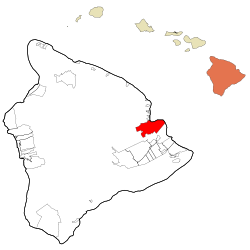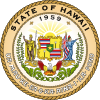Hilo, Hawaii
This article may have too many red links. (November 2011) |
Hilo, Hawaii | |
|---|---|
 Location in Hawaii County and the state of Hawaii | |
| Coordinates: 19°42′20″N 155°5′9″W / 19.70556°N 155.08583°W | |
| Country | United States |
| State | Hawaii |
| County | Hawaii |
| Area | |
| • Total | 58.3 sq mi (151.0 km2) |
| • Land | 53.4 sq mi (138.3 km2) |
| • Water | 4.9 sq mi (12.7 km2) |
| Elevation | 59 ft (18 m) |
| Population | |
| • Total | 44,186 |
| • Density | 760/sq mi (290/km2) |
| Time zone | UTC-10 (Hawaii-Aleutian) |
| ZIP codes | 96720-96721 |
| Area code | 808 |
| FIPS code | 15-14650 |
| GNIS feature ID | 0359187 |

Hilo (pronounced /ˈhiːloʊ/) is the second-largest CDP in the State of Hawaiʻi and the largest settlement on the island of Hawaiʻi with a population of 44,186 during the 2020 census.[1]
Hilo is the county seat of Hawaiʻi County, Hawaiʻi,[2] and is in the South Hilo District. The town overlooks Hilo Bay.
Hilo is near two shield volcanoes
- Mauna Loa, an active volcano, and
- Mauna Kea, a dormant volcano
Some of the best ground-based astronomical observatories are on Mauna Kea.
Hilo is home to the University of Hawaiʻi at Hilo, as well as the Merrie Monarch Festival, a week-long celebration of ancient and modern hula, which takes place every year after Easter. It is also home to the Mauna Loa Macadamia Nut Corporation, one of the world's leading producers of macadamia nuts. It is served by Hilo International Airport, inside the CDP.[3]
History
[change | change source]
Although there is not much archaeological evidence, people lived in the areas along Hilo Bay, Wailuku and Wailoa Rivers before the Western world made contact.[source?] They were known as the Hilo. They dominated the high mountaintops until the middle 1800s.[source?] Hilo means high mountaintop in the original language of the native peoples who lived on the mountaintops. King Kamehameha, the first king of Hawaii, conquered all the islands and then moved the Hilo mountain settlement to the shore after the arrival of outsiders.
Originally, the name Hilo applied to the whole district of Hilo, now divided into South Hilo District and North Hilo District. When William Ellis visited in 1823, the main settlement in Hilo district was Waiākea on Hilo Bay.[4] Missionaries came to the district in the early to middle 1800s, founding several churches, notably Haili Church, in the area of modern Hilo.
Hilo expanded as sugar plantations in the surrounding area created new jobs and drew in many workers from Asia, making the city a trading center.
A breakwater across Hilo Bay was begun in the 1900s and completed in 1929. On April 1, 1946, a 7.8 magnitude earthquake near the Aleutian Islands created a fourteen-meter high tsunami that hit Hilo 4.9 hours later, killing 160 people. In response an early warning system, the Pacific Tsunami Warning Center, was established in 1949 to track these killer waves and provide warning. This tsunami also meant the end of the Hawaii Consolidated Railway, and instead the Hawaii Belt Road was built north of Hilo using some of the railbed.[5]

On May 23, 1960, another tsunami, caused by a 9.5 magnitude earthquake off the coast of Chile the previous day, claimed 61 lives allegedly due to people's failure to heed warning sirens. Low-lying bayfront areas of the city on Waiākea peninsula and along Hilo Bay, previously populated, were rededicated as parks and memorials.
Geography and climate
[change | change source]

Hilo is at 19°42′20″N 155°5′9″W / 19.70556°N 155.08583°W (19.705520, -155.085918).[6]
Hilo is classified by the United States Census Bureau as a census-designated place (CDP), and has a total area of 58.4 square miles (151.3 km2), 54.3 square miles (140.6 km2) of which is land and 4.2 square miles (10.9 km2) of which (7.10%) is water.

Hilo features a tropical rainforest climate (Köppen climate classification: Af), with substantial rainfall throughout the course of the year. Hilo's location on the eastern side of the island of Hawaiʻi (windward relative to the trade winds) makes it the fourth-wettest city in the United States, behind the southeast Alaskan cities of Whittier, Ketchikan and Yakutat, and one of the wettest in the world. An average of around 126 inches (3,200 mm) of rain fell at Hilo International Airport annually between 1971–2000, with 275 days of the year receiving some rain.[7] At some other weather stations in Hilo the annual rainfall is above 200 inches (5,100 mm).[8]
Monthly average temperatures range from 71.4 °F (21.9 °C) in January to 76.3 °F (24.6 °C) in August. The highest recorded temperature was 94 °F (34 °C) on May 20, 1996, and the lowest 53 °F (12 °C) on February 21, 1962.[9] The wettest year was 1994 with 182.81 inches (4,643.4 mm) and the driest year was 1983 with 68.09 inches (1,729.5 mm). The most rainfall in one month was 50.82 inches (1,290.8 mm) in December 1954. The most rainfall in 24 hours was 27.24 inches (691.9 mm) on November 2, 2000.[10]
Hilo's location on the shore of the funnel-shaped Hilo Bay also makes it vulnerable to tsunamis.[11]
Education
[change | change source]There are many educational institutions in Hilo. Some of these are the University of Hawaiʻi at Hilo and Hawaiʻi Community College.
Culture
[change | change source]Notable natives and residents
[change | change source]Points of interest
[change | change source]



- Banyan Drive
- Coconut Island
- East Hawaii Cultural Center
- Haili Church
- Hilo Tropical Gardens
- Hilo Art Museum
- ʻImiloa Astronomy Center of Hawaiʻi
- Kalakaua Park
- Liliʻuokalani Park and Gardens
- Lyman Museum
- Mauna Loa Macadamia Nut Corporation
- Mokupāpapa Discovery Center for Northwestern Hawaii's remote coral reefs[12]
- Nani Mau Gardens
- Naha Stone (associated with Kamehameha I) in front of the Hilo Public Library
- Onomea Bay Scenic Drive
- Pacific Tsunami Museum
- Pana'ewa Rainforest Zoo
- Prince Kuhio Plaza
- Rainbow Falls (Waianuenue) & Boiling Pots on the Wailuku River
- University of Hawaiʻi at Hilo Botanical Gardens
- Wailoa River State Recreation Area with King Kamehameha Statue
References
[change | change source]- ↑ 1.0 1.1 "QuickFacts: Hilo CDP, Hawaii". United States Census Bureau. Retrieved August 2, 2023.
- ↑ "Find a County". National Association of Counties. Retrieved 2008-01-31.
- ↑ "Hilo CDP, Hawaii Archived 2011-11-24 at the Wayback Machine." U.S. Census Bureau. Retrieved on May 21, 2009.
- ↑ Ellis, W. A Narrative of an 1823 Tour through Hawai'i, republished 2004, Mutual Publishing, Honolulu ISBN 978-1-56647-605-8, chapters 11 and 12
- ↑ Jeane Branch Johnston (May 2003). "Personal Accounts from Survivors of the Hilo Tsunamis of 1946 and 1960: Toward a Disaster Communications Model". Master's Thesis. University of Hawaii. Retrieved 2009-07-23.
- ↑ "US Gazetteer files: 2000 and 1990". United States Census Bureau. 2005-05-03. Retrieved 2008-01-31.
- ↑ "NCDC: U.S. Climate Normals" (PDF). National Oceanic and Atmospheric Administration. Retrieved 10 November 2009.[permanent dead link]
- ↑ Hilo, Hawaiʻi information on NOAA web site
- ↑ "Monthly Averages for Hilo, HI". The Weather Channel. Archived from the original on 2013-07-18. Retrieved 2010-04-04.
- ↑ Record 24-hour rainfall on NOAA web site
- ↑ "Where is Hilo Hawai'i?". Frequently Asked Questions. The Pacific Tsunami Museum web site. Archived from the original on 2009-05-28. Retrieved 2009-07-23.
- ↑ "Education - Discovery Center". Papahānaumokuākea Marine National Monument web site. NOAA. Archived from the original on 2009-10-18. Retrieved 2009-08-25.
Other websites
[change | change source]- Hilo Downtown Improvement Association Archived 2007-09-27 at the Wayback Machine
- Pacific Tsunami Museum
- `Imiloa Astronomy Center of Hawai`i


